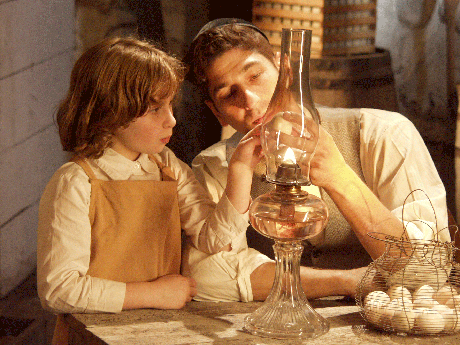A documentary 10 years in the making, Ida’s Story had its big-screen debut at North Minneapolis’s historic Capri Theater on Nov. 16. The premiere drew nearly a full house; over 250 attended to see the new film by a local cast and crew led by executive producer Donna Sherlock and producer/director Barbara Wiener.
Sherlock is the daughter of Ida Sokoloff, the film’s subject, who was only eight in 1918, when the Cossack army came into her Ukraine village. Ida’s Story chronicles the years Sokoloff and her family spent fleeing their native country in pursuit of freedom in America.
 Young Ida Sokoloff (Abby Kozberg) helps her father, Schlomo (Jeffrey Richman), candle eggs. (Photo: David McGrath)
Young Ida Sokoloff (Abby Kozberg) helps her father, Schlomo (Jeffrey Richman), candle eggs. (Photo: David McGrath)
The film begins with a shot of Ida in a beauty salon with a group of friends. When asked how she’s feeling on that particular day, she says she is feeling good, which was unusual for her. Perhaps it was the beauty treatment that made this day different, or perhaps it was a rush of relief in telling her story, which she worries about telling children. Early on, she wonders aloud, is telling children her story the right thing to do? Or should they be protected from the horrible things that have happened in the past?
Ida’s Story isn’t a happy one, but is certainly one to tell. It is mostly tragic, beginning with the death of Ida’s mother when Ida was only a baby. She remembers little of her mother beyond her wool dress, her beauty, and the blanket that covered her casket. Ida and her siblings are orphaned six months into their journey, as their father is caught as they attempt to flee the border. The children persevere, and learn quickly how to adapt and survive on their own, until they finally reach a cousin in America.
Ida herself has a limited perspective on the series of events, which were too intense and confusing for a child to comprehend. But unlike images of her mother, an image that remains vivid in memory is the moment when the Cossacks entered her village.
Eric D. Weitz, a professor of Jewish studies at the University of Minnesota, is the first expert to appear in the film. He explains that Christians and Jews coexisted peacefully in Europe up until World War I.
Ann S. Masten, a professor at the U of M’s Institute of Child Development, explains the psychological impact of the event, noting in particular the children’s ability to adapt. She says that after a disaster, the best thing for victims is to have important roles, which gives them something to focus on instead of the trauma that occurred.
Ida recalls the family’s various means of survival, from going door to door and telling their story to stealing from the market. She throws a bit of humor into the anecdote, noting that her sister’s conscience was too strong, and that Ida herself was “the stealer.”
The film was made to educate. As Sherlock explains in an e-mail: “Our vision has always been to use the film as a catalyst for discussion with classrooms, congregations, community and youth groups, etc. We want Ida’s Story to be used as a tool to help individuals and groups address issues of ethnic and racial hatred and violence, as well as other issues raised through the film. ”
Above all, Ida’s Story aims to answer the question of why these events keep happening. When Ida is asked if she knew why Jews were hated, she responded, “there’s no way to figure it out.” She sees it simply as living in fear.
Robert J. Sternberg, the dean of arts and professor of psychology at Tufts University, explains it as “a story.” It’s the story, rather than the events, that drive the hate. Cynical leaders, he says, lose grip on a group, and need to create an external enemy.
During the question and answer period following the film’s first public screening, both Sherlock and Wiener referred to Sternberg’s claim there is no such thing as a bystander. Historically, there have been enough people not doing anything, and allowing hate to repeat again and again. Ida’s Story is meant as the story of all immigrants, a story lived and known all over the world.
DVD copies of Ida’s Story can be ordered online . Also, the film’s producers are accepting donations for curriculum development and outreach.
This story originally appeared on Twin Cities Daily Planet.
©2009 Crystal Erickson









 Young Ida Sokoloff (Abby Kozberg) helps her father, Schlomo (Jeffrey Richman), candle eggs. (Photo: David McGrath)
Young Ida Sokoloff (Abby Kozberg) helps her father, Schlomo (Jeffrey Richman), candle eggs. (Photo: David McGrath)









